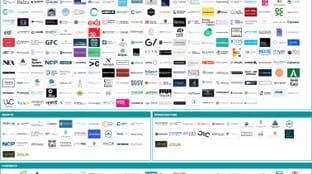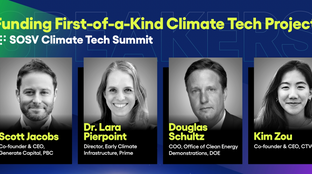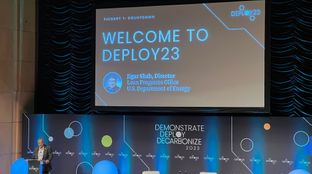
🌏 Who are the Climate Tech Investors?
A new interactive Climate Capital Stack Map
Cassie Bowe is Vice President at Energy Impact Partners (EIP), an investment fund partnering with companies shaping the energy landscape of the future.

Cassie Bowe is Vice President at Energy Impact Partners (EIP), an investment fund partnering with companies shaping the energy landscape of the future. Prior to joining EIP, Cassie worked for 5 years at SunPower, one of the largest global solar companies, in policy and strategy. At SunPower she was responsible for global market analysis, legal and regulatory assessment, and new country entry. She has also gained operating experience at energy storage, micro-grid, and energy asset management startups in business development and finance roles. Ms. Bowe holds an MBA from the Stanford Graduate School of Business, a BA in Economics from Harvard University, and was selected for Forbes 30 Under 30 in Energy (2018).
Since the beginning of college, I’ve wanted to go into energy. At that time, I was a wide-eyed 19 year old wanting to do something good for the climate, but didn’t know much about renewables or electricity. As I learned more, I realized that now is the most interesting time in the energy industry since electricity was first created. I interned at a few solar companies in college and went to SunPower full-time for 5 years. While there, I focused on how policy and strategy was changing and what that meant for business. I knew that I didn’t want to do policy my whole career, so I went to Stanford. I thought I’d go to a startup, and worked at 3 different energy tech startups, but decided the financing side is as crucial as the technology and policy side. Since I’d already done policy at SunPower and focused on tech at GSB, I decided to get the third stool covered learning about finance, so I went to Energy Impact Partners.
The thing about our world is that you need to know how policy and regulation work. There is no free market for electricity as it’s completely regulated. Building this foundation and learning this core skill set is invaluable in order to function in this industry, from figuring out how the grid functions to how the independence of operators works. Another cool aspect about being involved in policy was that I could go meet with state senators, draft bills, and get them passed – there was some impact you could measure. The hard part was a lot of it felt out of my control and the policy cycle, from drafting to implementation and feedback, was really long.
On the startup side, I enjoyed working where you’re closest to the action and able to have the most impact – it would’ve been a really interesting route to go as well. One downside to investing, similar to the policy world, is that you’re funding and advising one step removed. However, in contrast to a startup where I would only focus on one narrow thing, at EIP, I can look at startups across the space and work with utilities all within the same role. Our model is something that makes it feel real and tangible because we’re partnered with the companies our portfolio are trying to work with.
We’ve had two funds so far, with the first (over $500 million) completely allocated, and now investing out of the second fund ($750 million). 80% of the capital comes from utilities and a mix of financial and strategic investors financially motivated in decision making. The reason utilities invest in us is to gain strategic insight into the market and how to work with emerging companies, as well as develop potential revenue channels. On the other side, our portfolio companies have taken us on to gain traction with utilities, as working with a utility is slower than what the typical startup cycle looks like. We have 20 different utilities and investors in our 2nd fund and partner with over 70 different operating companies, which makes it a lot easier to prioritize which teams to work with. As a result, utility investors have done over $200 million in commercial bookings with our portfolio.
The world has changed a lot since I first got into solar. When I was working on solar policy, utilities and the solar industry were on different sides of the argument for distributed generation. That’s completely changed. For utilities now, distributed generation is a fact of life and something they’re excited about. We poll utilities every 6 months, and distributed generation, solar, wind, energy storage, and electric vehicles are all big parts of their priorities. To me it’s not a question of where they stand on this; they’re more forward leaning than anybody in terms of how they think about that future generation. One of the biggest pieces of evidence of this is that EIP as a fund even exists, that you can pull a huge group of utilities together and invest for a second fund. It’s a testament to how the world has changed – this wouldn’t have happened 10 years ago.
We fit our strategy into these buckets: energy, transportation and mobility, cybersecurity, smart homes, buildings and cities, IoT, and industrial digitization. On the energy side, you have things that support the utilities’ core business and things that are potentially disruptive to utilities as well. It could be everything from storage to electric vehicles, smart grid technology to new generation technology, energy management and solutions, hardware to software and in between.
In terms of areas we think are the most impactful in mitigating GHG, we went through the exercise of quantifying the GHG emissions of our companies. Almost all our investments happen to be cleantech-related because that’s where innovation is in the space. For example, we invested in a smart thermostat company – when we did that calculation it was pretty impactful because HVAC is the biggest load in residential homes. We’ve also found transportation electrification to be a huge emissions lever across the board.
I’ve spent a lot of my time on transportation electrification. When surveying utilities, transportation and specifically electric vehicle charging has been the #1 priority area for the past 4 years. That’s something we really care about – one investment is Viriciti, which has a real time operating optimization system for heavy duty vehicles ranging from electric transit buses to grocery delivery vans. Operating an electric vehicle is very different compared to an internal combustion vehicle in terms of multiple factors such as how you brake and where your energy is being generated. In electric vehicles, braking regenerates the battery and energy capacity depends on weather, topography, the number of passengers and so on. Through driver behavior, the battery can have a 20% difference in range. We are at a critical transition in transportation electrification; if people have bad experiences operating EVs, it could set back the trend. In this market, the #1 metric is fleet uptime, or how much time the vehicle fleet is actually on the road. We’ve talked to customers from using less than 50% of battery range to using more than 90% of capacity.
In general, we use the same metrics as other investors such as revenue, customer mix and pipeline. We also look at things that are relevant to our investors – whether we can be helpful to companies by introducing them to our utilities. Most importantly, we focus on team, quality and traction of the product, their competitive advantage and market opportunity.
From a landscape perspective, we’re operating under conservative assumptions that this is going to be a prolonged recession. The effects on energy, electricity, and startups in the space are really interesting. Utilities are going to be well-positioned relative to other companies because of the regulated and essential nature of their services. All utilities are seeing residential energy demand increase by a lot while commercial demand is going down. We are continuing to understand how these trends impact our sector but I do think the ramifications are going to last for quite a while.
In terms of time split, we are spending a lot of time with our current portfolio to make sure they’re well positioned and funded. Helping them through this ends up taking a lot of time away that could be spent with new companies. However, some of the best companies are born out of periods like this and we will continue talking to new companies in the future.
Climate tech as a sector went from really uncool 8 or so years ago to getting increasingly cooler every year as more capital and investable companies accelerate into the space. Towards the end of 2019, we saw a lot more mainstream investors become interested in climate tech. I’m really curious to see how this recession and immediate situation impacts that: I hope people double down to take global threats really seriously, but it is yet to be seen whether climate tech will become even cooler as a result of the current crisis.
Interested in more content like this? Subscribe to our weekly newsletter on Climate Tech below!

A new interactive Climate Capital Stack Map

Financing around first- or early-of-a-kind project risk

‘Government-enabled, private sector-led’ in action in Washington, DC